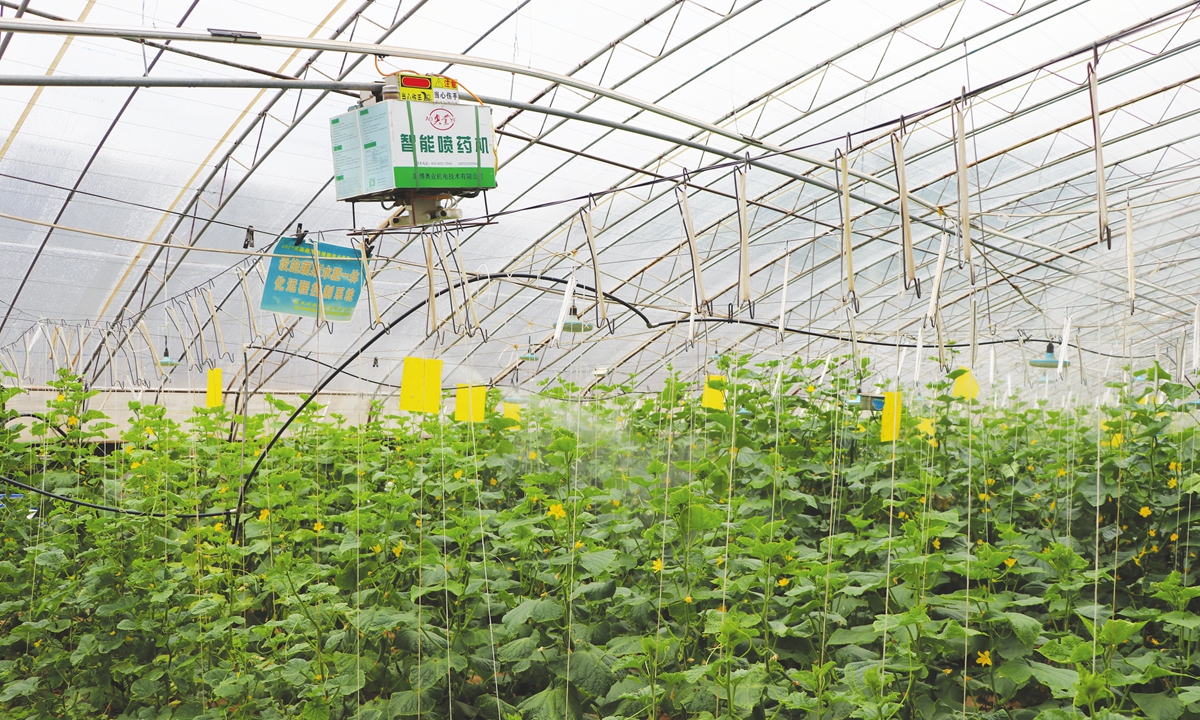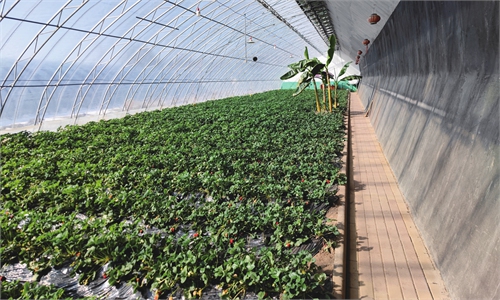
Intelligent spraying system in a greenhouse in Ansai district of Yan'an in Northwest China's Shaanxi Province Photo: Courtesy of Ansai Rural Revitalization Administration
Ansai district is located in Northwest China's Shaanxi Province's Yan'an city, and some residents were not well off due to geography and drought. Empowered by technology, the local government has vigorously developed water-saving agriculture, and is making every effort to promote the efficient and green development of modern agriculture, mainly including greenhouse vegetables, mountain apples and livestock breeding, continuously promoting the rural revitalization.
In 2022, per capita net income of local residents who were lifted out of poverty reached 15,171 yuan ($2,131.7), an increase of 378 percent compared with 2014, Cao Zhenyu, Secretary of the Ansai District Committee of the Communist Party of China, said during Shanghai Cooperation Organization Forum on Poverty Reduction and Sustainable Development on May 29.
Agricultural technology
On the top of the hills in Nangou, rows of fruit trees are neatly arranged, and water and fertilizer integrated drip irrigation pipes extend straight from the roots of the trees, providing a constant source of water and organic fertilizer for each tree to thrive.
"Drip irrigation water in the orchards is pumped from the bottom of the dam at the bottom of the ditch. We built a cistern at the top of the hill, and dissolve the fertilizer in water for drip irrigation, which achieved efficient use of water and fertilizer," Zhang Gang, director of Fruit Industry Technical Service Center said.
In addition to drip irrigation technology, the orchards implemented a series of agricultural modernization technology measures, including disaster prevention and mitigation as well as green prevention and control, so as to achieve efficient management of the orchards with bumper crop, Zhang added.
"Now we don't need to pick water for irrigation, and the orchard is hailstorm-proof. Without strong government support, how can the apples on our mountain go to the whole country?" said Liu Runxi, a major apple grower who earned 250,000 yuan last year.
Ma Rui, director of the Bureau of Agriculture and Rural Affairs in Ansai, said that the district is located in the middle of the Loess Plateau, a typical hilly gully region. In the face of the special geographical environment, Ansai implements four water-saving irrigation models including rainwater collection in storage pool outside the shed, while promotes water and fertilizer integration technology for vegetables in the shed, with the establishment of 13 key technologies including an automatic hail protection network.
The district has developed 400,000 mu (26,666.67 hectares) of mountain apples, with annual output of 280,000 tons, and the total value reaching 1.59 billion yuan.
In addition, with the application of mechanized and modern equipment including automatic temperature control machines, local greenhouse industry has achieved the transformation of traditional planting to modern efficient planting.
In recent years, Ansai insists on taking the greenhouse vegetable industry as the pillar industry for rural revitalization. Up to now, the district has developed 71,000 mu of greenhouse vegetables. In 2022, the total vegetable output reached 315,000 tons with the value of 1.46 billion yuan.
Support for China's rice bowl
"Last year, the government established a demonstration base for interplanting soybean and corn in our village, and our average income per mu has increased, so the planting enthusiasm this year maintains high," said Gao Zhiqin, a farmer from Gaogoukou village in Ansai.
"We can harvest two kinds of food on one piece of land thanks to the government's policy," another villager Wang Lian said.
After the implementation of interplanting, farmers increase income of about 1500 yuan per mu.
In 2022, Ansai promoted the interplanting model of soybean and corn. Based on the premise of ensuring that corn production is not reduced, the increase in soybean harvest has important significance to ensure food security, especially to address the shortage of soybean supply, said Lu Xingguo, deputy director of the Bureau of Agriculture and Rural Affairs in Ansai.
The achievements made in Ansai are a vivid epitome of the great changes taking place in China. With more technological equipment put into use, agricultural sci-tech innovation has become a powerful support for rural revitalization.
In February, China unveiled "No. 1 central document" for 2023, outlining nine tasks for comprehensively promoting rural vitalization this year.
The document called for enhanced efforts to boost the construction of agricultural infrastructure, to strengthen support for agricultural science, technology and equipment, to consolidate and expand achievements related to poverty alleviation, and to promote the high-quality development of rural industries.

